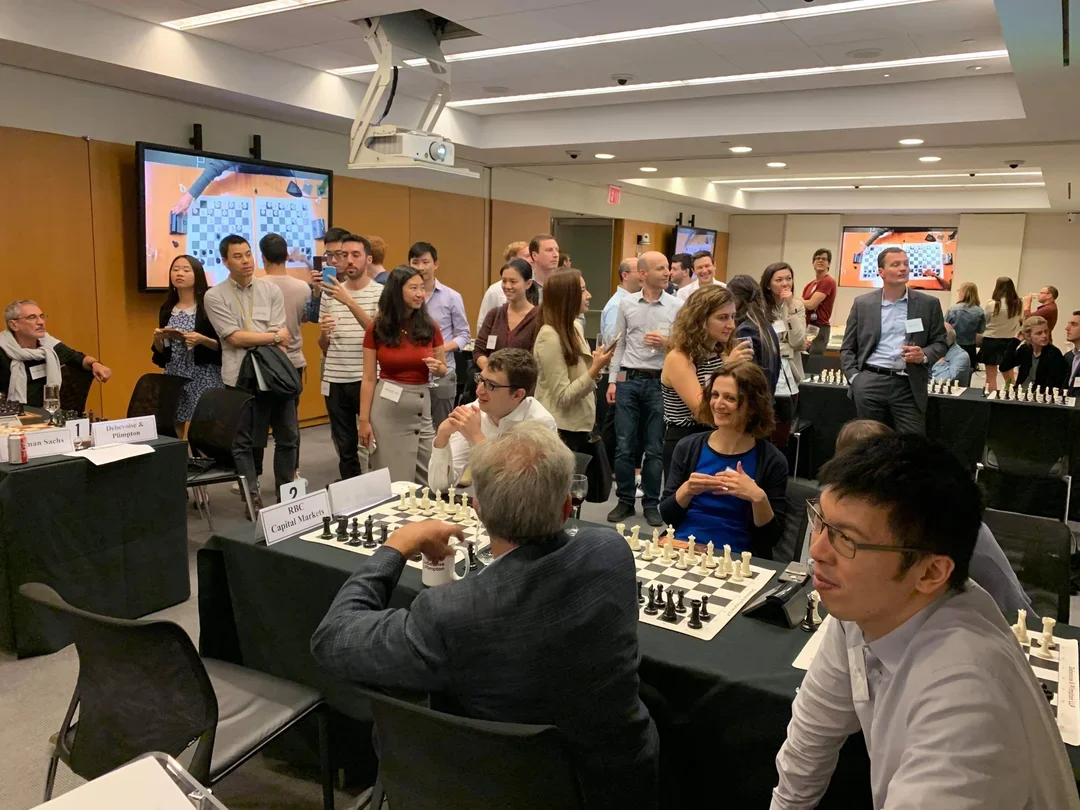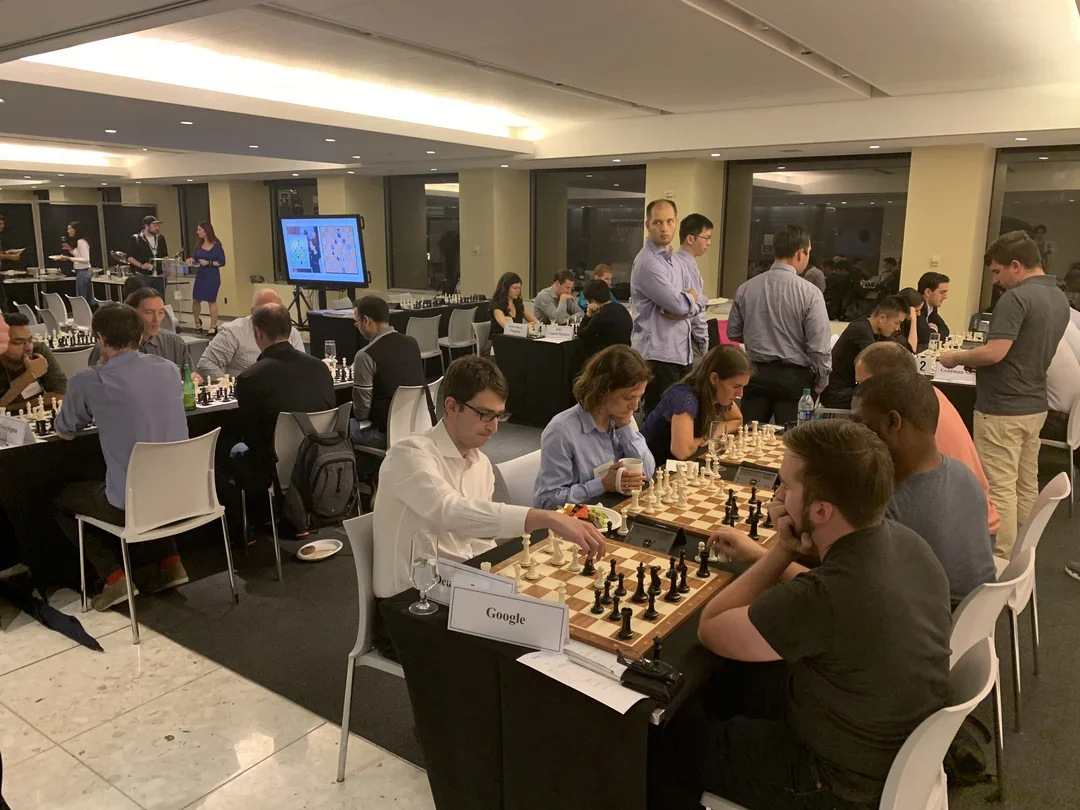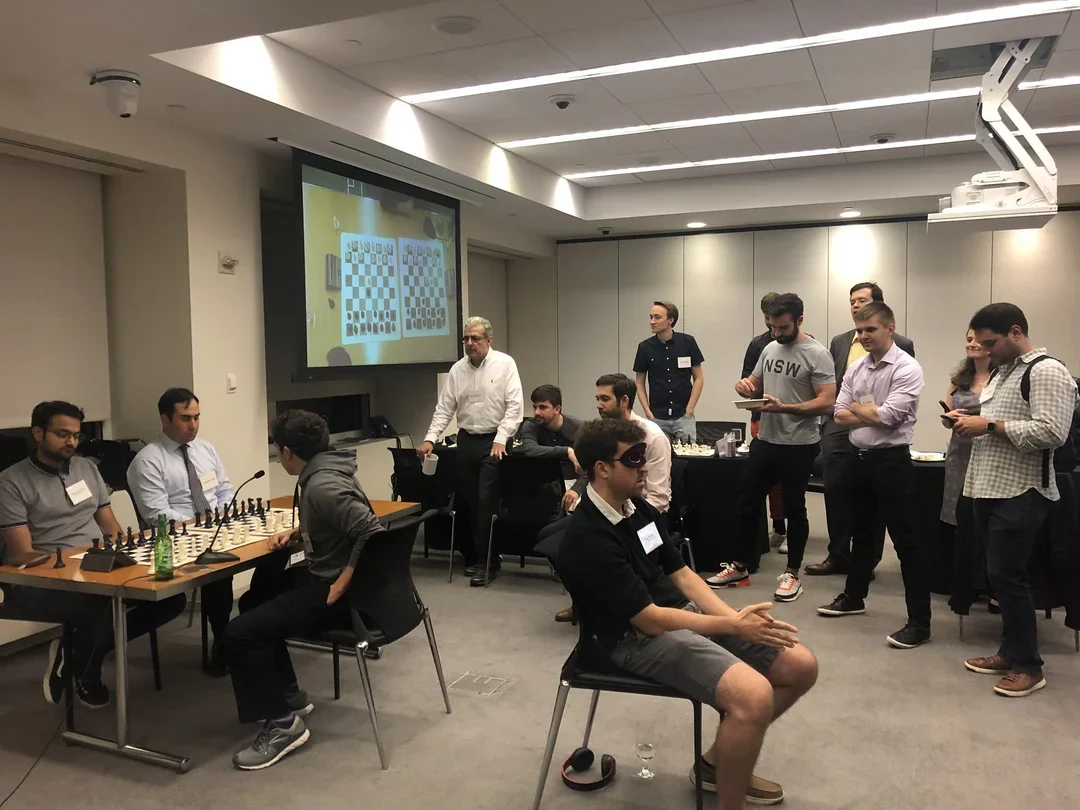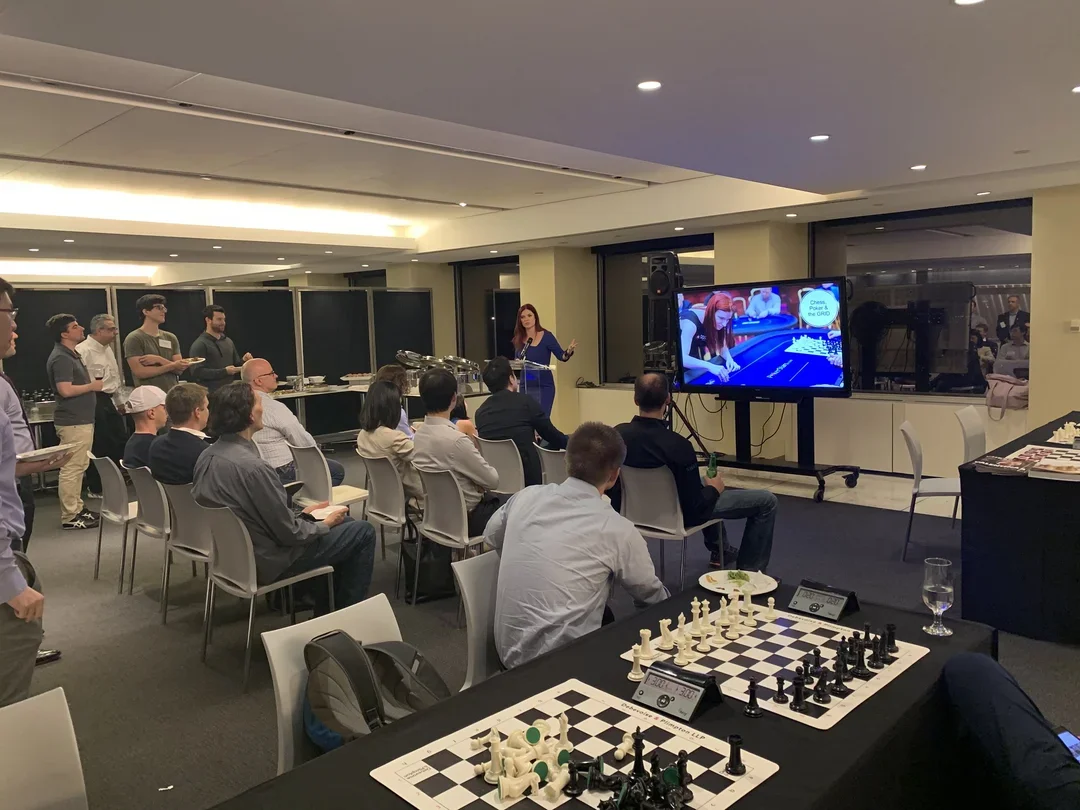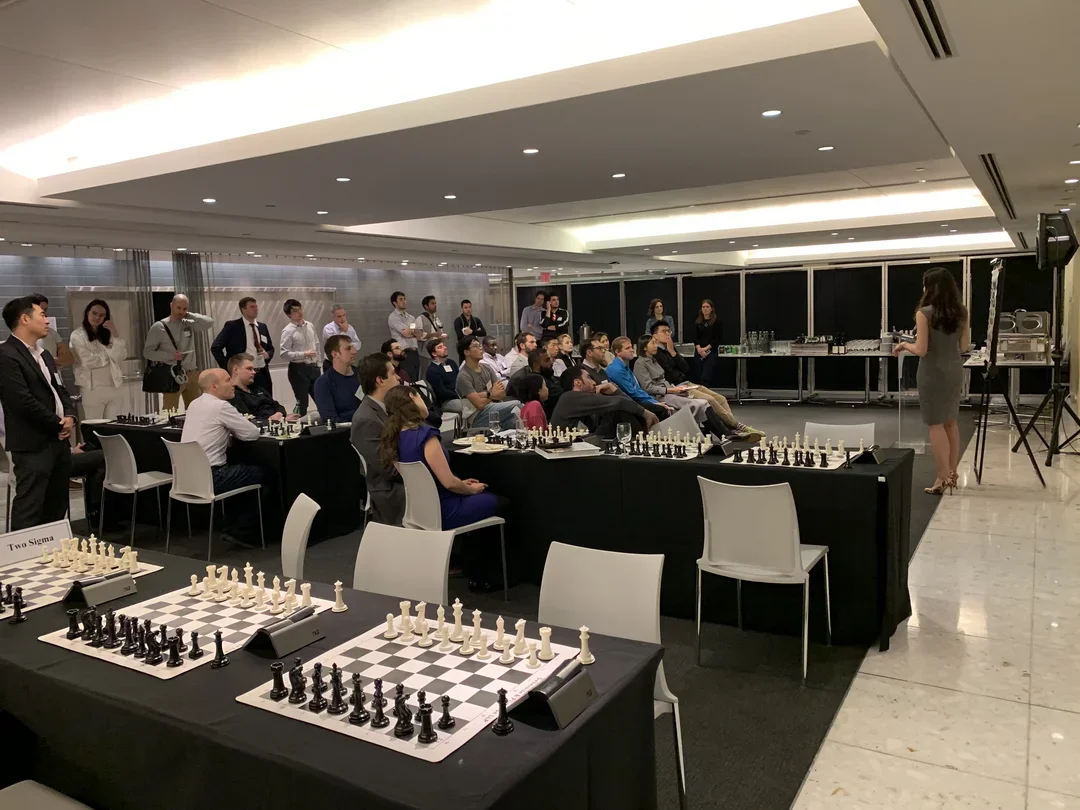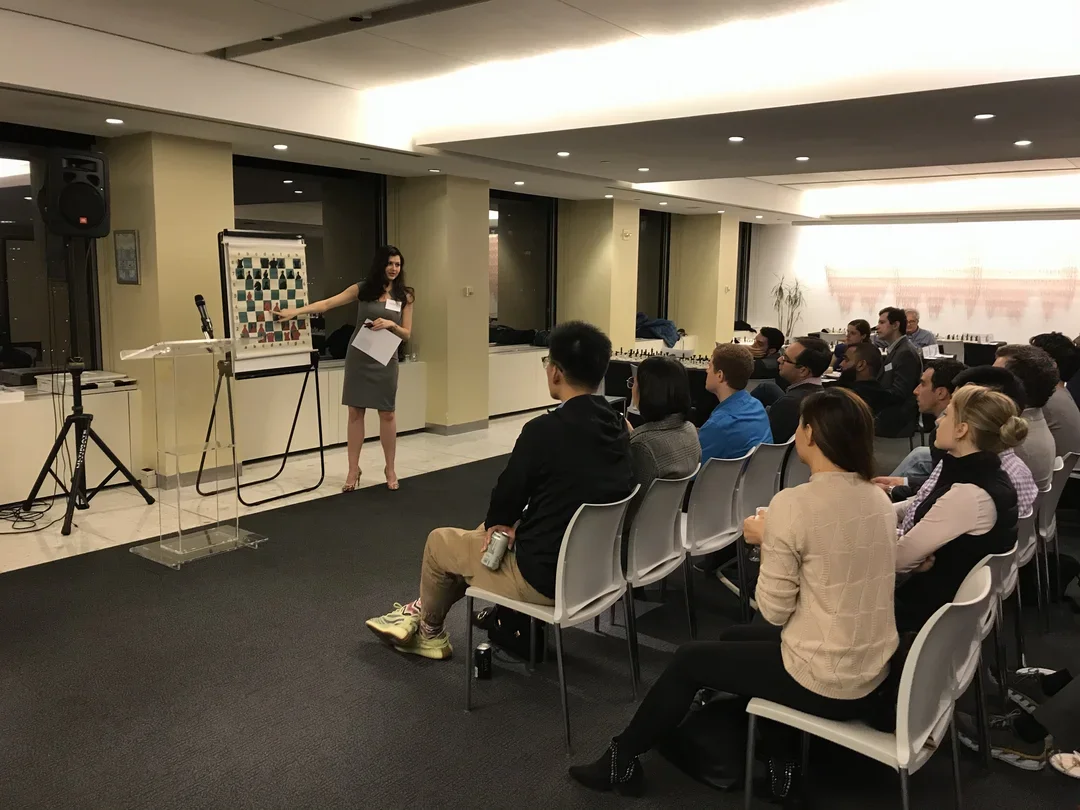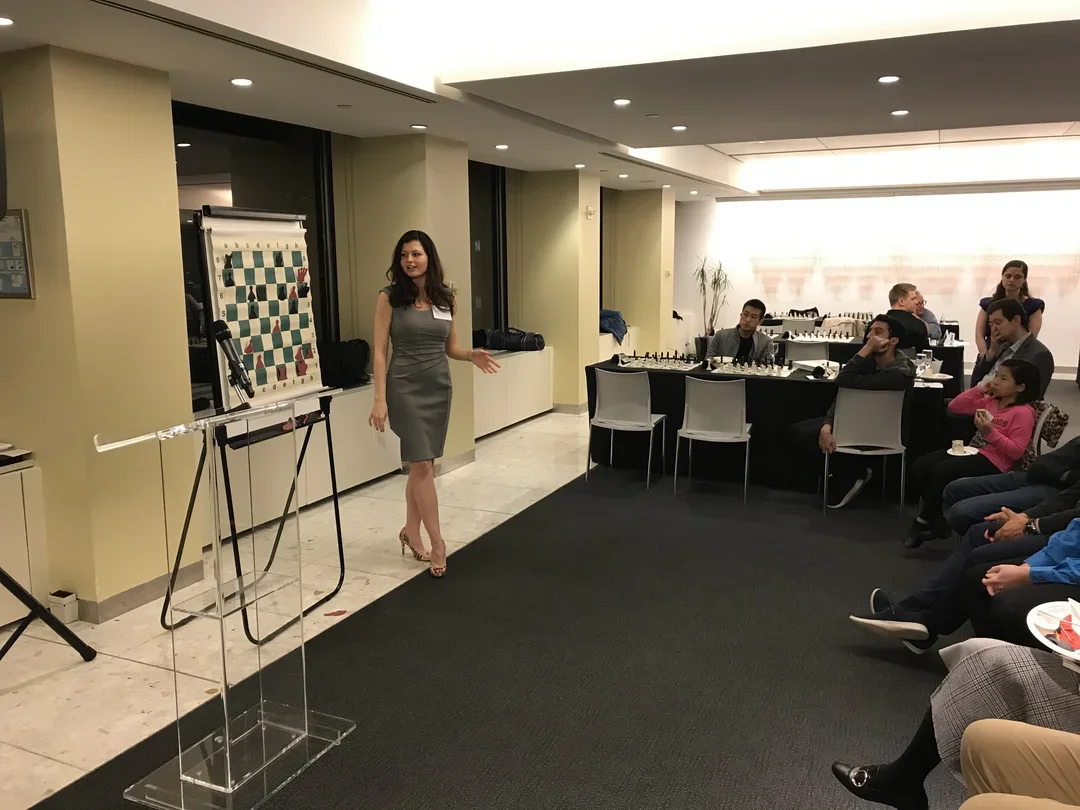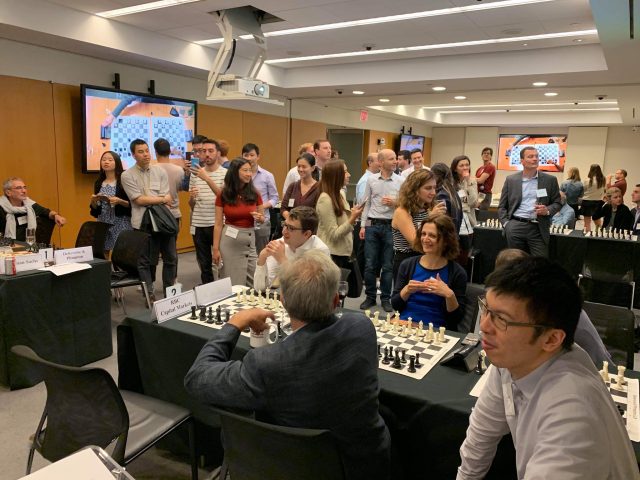 The 2019 fall season of the NYCCL is once again hosted at the offices of Debevoise & Plimpton, LLP. NYCCL co-founder, co-organizer, and Debevoise team captain FM Alisa Melekhina recaps the halfway report. The NYC Corporate Chess League involves three-player teams from banks, firms, and corporations across New York City. The teams play six double-matches of G/10 + 3’ over the course of two months, vying for the title of NYC Corporate Chess leader. The inaugural 2018 season concluded with Deutsche Bank securing a perfect 6/6 score for a first-place finish. Building off of the successful draw among teams, players, and spectators in 2018, the second season is officially underway. The core line-up once again features teams from: Bank of America Merrill Lynch, Debevoise & Plimpton, Deutsche Bank, Goldman Sachs, Google, JPMorgan Chase, RBC Capital Markets and Two Sigma. "We are delighted to welcome back the teams for another installment of friendly competition to determine the city’s next corporate chess leader," says Debevoise partner Gregory J. Lyons, leader of the law firm's Banking Industry Group and member of the firm's Financial Institutions Group. “We look forward to building off the success of the first season in establishing a thriving corporate chess community in New York.” This year, however, defending champion Deutsche Bank is only the second seed. Since last year, Goldman’s team has a new board 1 in the form of IM Zhe Quan. Close behind on board 2 is IM Bogdan Vioreanu, with board three rounded off with a selection of strong experts.
The 2019 fall season of the NYCCL is once again hosted at the offices of Debevoise & Plimpton, LLP. NYCCL co-founder, co-organizer, and Debevoise team captain FM Alisa Melekhina recaps the halfway report. The NYC Corporate Chess League involves three-player teams from banks, firms, and corporations across New York City. The teams play six double-matches of G/10 + 3’ over the course of two months, vying for the title of NYC Corporate Chess leader. The inaugural 2018 season concluded with Deutsche Bank securing a perfect 6/6 score for a first-place finish. Building off of the successful draw among teams, players, and spectators in 2018, the second season is officially underway. The core line-up once again features teams from: Bank of America Merrill Lynch, Debevoise & Plimpton, Deutsche Bank, Goldman Sachs, Google, JPMorgan Chase, RBC Capital Markets and Two Sigma. "We are delighted to welcome back the teams for another installment of friendly competition to determine the city’s next corporate chess leader," says Debevoise partner Gregory J. Lyons, leader of the law firm's Banking Industry Group and member of the firm's Financial Institutions Group. “We look forward to building off the success of the first season in establishing a thriving corporate chess community in New York.” This year, however, defending champion Deutsche Bank is only the second seed. Since last year, Goldman’s team has a new board 1 in the form of IM Zhe Quan. Close behind on board 2 is IM Bogdan Vioreanu, with board three rounded off with a selection of strong experts.
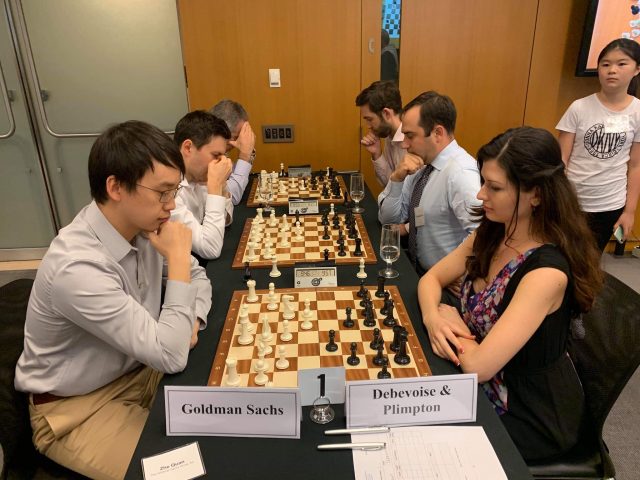 Zhe Quan vs. Alisa Melekhina
Zhe Quan vs. Alisa Melekhina[pgn] [Event "NYCCL 2019 Season 2"] [Site "NYC"] [Date "2019.09.18"] [Round "1.1"] [White "Quan, Zhe IM"] [Black "Melekhina, Alisa FM"] [Result "1-0"] [ECO "A45"] [WhiteElo "2503"] [BlackElo "2300"] [PlyCount "77"] [EventDate "2009.09.02"] [Source "Mark Crowther"] [WhiteTeam "Goldman Sachs"] [BlackTeam "Debevoise"] 1. d4 Nf6 2. Bg5 g6 3. Bxf6 exf6 4. e3 f5 5. Ne2 Bg7 6. g3 d6 7. Bg2 O-O 8. c4 Nd7 9. Nbc3 Nf6 10. Qd3 c6 11. b4 {White chooses to delay castling, rendering Black's usual plan of expanding on the Kingside a bit awkward to execute immediately.} Re8 12. b5 Bd7 13. a4 Qa5 $6 {A creative attempt to halt white's progress on the Queenside and force him to castle, but at the same time losing tempos and rerouting White's knight to an arguably more effective square.} 14. O-O h5 15. Nc1 h4 16. Nb3 Qd8 17. a5 a6 18. bxc6 bxc6 19. Na4 hxg3 20. hxg3 Ng4 21. Nb6 Rb8 (21... Ra7 {As soon as I played Rb8, I knew that Ra7 was the more optimal choice given it simultaneously defends a6 and the d7-Bishop. I had inklings of exchanging the Rook for the b6 knight, but they did not materialize.}) 22. c5 d5 23. Qxa6 Bc8 (23... Nxe3 $1 24. fxe3 Rxe3 25. Rab1 Qg5 $15 {Once the g3 pawn inevitably falls, I would have had the counterplay I was striving for all along.} (25... Rxg3 26. Rf3 Rxf3 27. Bxf3 Qg5+ 28. Kf1 Re8 29. Nxd7 Qf4 30. Kg2 Qg5+ 31. Kf2 Qe3+ 32. Kg3 Qg5+ $11)) 24. Qd3 Qg5 25. Rfe1 Qh5 26. Nd2 f4 $1 {Losing another pawn, but opening the light-squared Bishop to join the attack, while loosening White's fortress.} 27. exf4 (27. gxf4 Qh2+ 28. Kf1 Bf5 29. Qc3 Qh4 30. Re2 Rb7 {the computer suggests this incredibly calm line where Black simply consolidates with Ra7 and then proceeds to put pressure on White through an eventual Bh6 manuever.}) 27... Bf5 {played automatically in this quick time control, but losing out on a decisive opportunity. Though, the winning line was very difficult to see.} (27... Ba6 $3 28. Qxa6 Bxd4 {this is the key to the line, and why Ba6 was not focused on. Even though White has an extra move, incredibly, he cannot meaningfully defend f2. Even after this, I would have had to see the idea of transferring the Queen over via h8.} 29. Rxe8+ Rxe8 30. Nf3 (30. Rf1 Qh2#) 30... Bxf2+ 31. Kf1 Qh8 $1 32. Rb1 Qc3 33. Ne5 Bxc5 34. Nxg4 Qd4 {#11/0}) 28. Qc3 Qh2+ 29. Kf1 Qh8 $1 {The Queen has served its purpose, and now makes a counter-intuitive manuever to put pressure on the center.} 30. Nf3 Be4 (30... Nh2+ $1 31. Nxh2 ( 31. Kg1 Nxf3+ 32. Qxf3 Bxd4 33. Rxe8+ Rxe8 34. Rc1 Bxc5 35. Rxc5 Re1+ 36. Bf1 Bh3 $19) 31... Bxd4 32. Rxe8+ Rxe8 33. Re1 Rd8 34. Qd2 Bc3 $19 {this line uncovers another counter-intuitive feature of the position. The Queen cannot keep attacking the d4-Bishop, and thus Black comes out ahead after freely recapturing the knight or e1-Rook, depending on where the Queen moves.}) 31. Rxe4 dxe4 32. Ne5 Bxe5 (32... Nxe5 {A viable option, but even with the slight material edge, Black is unable to resist against White's powerful pawns.} 33. fxe5 Rxe5 34. dxe5 Bxe5 35. Qe1 Bxa1 36. a6 $16) 33. fxe5 Nh2+ (33... e3 34. fxe3 Qh2 35. Qe1 f6 $13 {The final chance Black had to turn the tables.}) 34. Kg1 Ng4 35. Re1 e3 {too late because White correctly seizes the opportunity to neutralize all of Black's attacking chances. White's pawns and minor pieces are so strong that he can even sacrifice the exchange twice and still come out on top. Even during the game, I appreciated the aesthetics of White's approach here.} 36. Rxe3 Nxe3 37. Qxe3 Qh5 38. Bf3 Qf5 39. Bxc6 {A few more futile moves were played before White eventually picked off Black's remaining army.} 1-0[/pgn]
[pgn] [Event "NYCCL 2019 Season 2"] [Site "NYC"] [Date "2019.09.18"] [Round "1.2"] [White "Melekhina, Alisa FM"] [Black "Quan, Zhe IM"] [Result "1/2-1/2"] [ECO "B12"] [WhiteElo "2300"] [BlackElo "2503"] [PlyCount "128"] [EventDate "2019.??.??"] [WhiteTeam "Debevoise"] [BlackTeam "Goldman Sachs"] {I only had a few minutes to recover from the chaotic first-round game, which was already nerve-wracking given I hadn't played an OTB tournament game in about a year. The quick G'10 time control did not help. Nevertheless, I had to collect myself for a solid, positional fight with White to salvage some points for my team. Every game point counts in the league.} 1. e4 c6 2. d4 d5 3. e5 c5 4. dxc5 e6 5. Be3 Nh6 6. c3 Qc7 7. Nf3 Nd7 8. Bb5 {A common idea to stall Black's pressure on the center, though in most lines the knight usually comes to c6.} Nf5 9. Bd4 Bxc5 10. O-O O-O 11. Bd3 {The Bishop has done its purpose. The knight on f5 is now significantly more of a bother than its d7 counterpart. From my time playing my favorite 9.Nbd2 gambit line in the Advanced French, I know the Bishop belongs on this long diagonal. Note the transposition of the structure, which had begun as a Caro-Kann.} Nxd4 12. cxd4 Be7 13. Nc3 {It was worth exchanging the dark-squared bishop to solidify my hold on e5 and to allow the knight an easy path to development. No pawn sac required here!} Qb6 14. Qc2 h6 15. Rac1 {White's moves play themselves.} Nb8 16. Na4 Qd8 17. a3 { It seems that White is on the offensive, but there is no need to rush with reactionary moves such as Qc7 that would lead nowhere. The correct plan is to continue amassing a space advantage with solid moves such as a3, while Black disentangles.} Nc6 18. b4 Bd7 19. Nc5 Rb8 20. b5 $6 {The plan started off well, but was not executed fully. b5 gives Black room to move and consolidate, whereas continuing to hold would really put the onus on Black to make any type of progress.} (20. Rfe1) 20... Na5 {And now Black has the new option of outposting his knight on c4.} (20... Nxd4 {This almost works.} 21. Nxd4 Rc8 22. Nxb7 Qb6 (22... Rxc2 23. Nxd8 Rxc1 24. Rxc1 Bxd8 25. Nc6 Bb6 26. a4 $11) 23. Nc6 $1) 21. Qa4 b6 22. Na6 Rc8 23. Nb4 {I thought I was making progress, but in reality, it was Black that optimized his pieces throughout my efforts.} Rc7 24. Rc2 Nc4 25. Rfc1 Qe8 26. Bxc4 dxc4 (26... Rxc4 27. Qxa7 (27. Rxc4 Bxb5) 27... Bxb5 28. Qxb6 $11) 27. Nc6 {Leading to a massive liquidation. While not forced, it seemed that both players opted for it out of risk-aversion.} Bxc6 28. bxc6 Qxc6 29. Qxc6 Rxc6 30. Rxc4 Rxc4 31. Rxc4 b5 32. Rc7 Bxa3 33. Rxa7 Rc8 34. Kf1 Bf8 (34... b4 {After the game, Zhe indicated he was hesitant about playing b4 immediately because it seemed to be restricting both pawn and bishop, with little prospects for promotion. However, it turned out that when coupled with the Rook on the second rank, the threat of Bc1 at the right time is quite strong. Even though White can hold, it is more uncomfortable than what transpired in the game. Once Black played Bf8, however, then White had to exert minimal effort, and I in fact had my own chances in the endgame.} 35. Ke2 (35. Rb7 Rc1+ 36. Ke2 Rc2+ 37. Ke1 g5) 35... Rc2+ 36. Nd2 Bc1 37. Kd1 Rxd2+ 38. Kxc1 Rxf2 $19) 35. Ke2 b4 36. Rb7 g5 37. Kd3 g4 38. Nd2 Kg7 39. Ne4 Rc6 40. Nd6 {Rushing to exchange off the pieces and eliminate the b4 pawn, when the b4 pawn is in fact a pseudo-threat at this point. Outposting the knight on f6 would cause Black more problems. Among them would be the loose g4/h5 pawns, as well as mounting pressure on f7.} (40. Nf6 $1) 40... Bxd6 41. exd6 Rxd6 42. Ke4 Kf6 43. Rxb4 Ra6 44. Rb8 Ra2 {Given the quick time control and that games are not recorded, the remainder is a rough approximation of how the final position emerged. Needless to say, the rook endgame resulted in a draw.} 45. Ke3 Ra3+ 46. Kf4 h5 47. Rd8 Ke7 48. Rh8 Rd3 49. Ke4 Rd2 50. Ke3 Ra2 51. Rxh5 Ra3+ 52. Kf4 Ra2 53. Kxg4 Rxf2 54. Kg3 Rd2 55. Rh4 Kd6 56. Kf3 Rd1 57. Ke4 Rg1 58. g4 Rg2 59. Rh7 Rf2 60. h4 Rh2 61. h5 Rh4 62. Kf4 f5 63. Rg7 fxg4 64. Rxg4 Rxh5 1/2-1/2[/pgn]
Deutsche Bank’s team once again features the powerhouse combination of: FM Igor Shneider and former U.S. Women’s Champions IM Rusudan (“Rusa”) Goletiani and WIM Elina Cotler (née Groberman).
The highest-ranked player in the league, however, hails from Bank of America Merrill Lynch: IM Victor Shen.
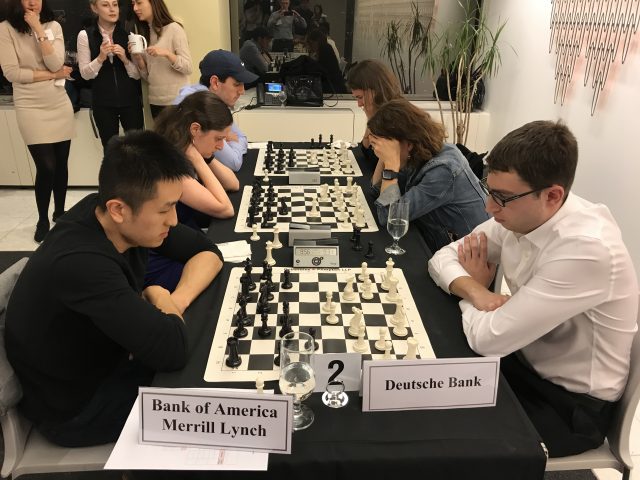 IM Victor Shen on board 1 in match 2 against Deustche Bank. BAML’s board 2 is co-team captain Anna Ginzburg, a familiar face in the NYC chess scene.
IM Victor Shen on board 1 in match 2 against Deustche Bank. BAML’s board 2 is co-team captain Anna Ginzburg, a familiar face in the NYC chess scene.“The NYCCL was created as an outlet for top chess players and enthusiasts alike to combine their chess experience with their new work environment,” notes FM Alisa Melekhina, who is currently a sixth-year litigation associate attorney at Debevoise and an internationally-ranked master and World Team Chess Championship gold medalist. “As a league founded by three female chess players, we’re proud to boast a diverse line-up of players and spectators across a range of roles and experiences.”
 The ladies of the league. Pictured from left to right during match 2: IM Rusa Goletiani, WGM Jennifer Shahade, and NYCCL founders & organizers Alexandra Wiener and FM Alisa Melekhina. Dropping in is the daughter of one of the RBC players.
The ladies of the league. Pictured from left to right during match 2: IM Rusa Goletiani, WGM Jennifer Shahade, and NYCCL founders & organizers Alexandra Wiener and FM Alisa Melekhina. Dropping in is the daughter of one of the RBC players.Four of the eight team captains are women, and players span the roles of software engineers, traders, lawyers, and banking VPs and executives, among others. Two of those team captains are the NYCCL co-founders and organizers, FM Alisa Melekhina and Alexandra Wiener. “It’s a pleasure to be back both in an organizer and team captain capacity for the second NYCCL season, which has already reached new milestones in terms of attendance and programming. The strength of the teams is increasing, as is spectator interest —two-fold goals of the league which we are proud to be surpassing,” comments Wiener, an Analyst at Goldman Sachs. Indeed, this season of the NYCCL has already featured a series of engaging presentations from prominent faces in the chess world. GM Mac Molner kicked off the season with a Grandmaster Blindfold exhibition match. Molner faced two brave volunteers from the competing teams, and ultimately won both of his games.
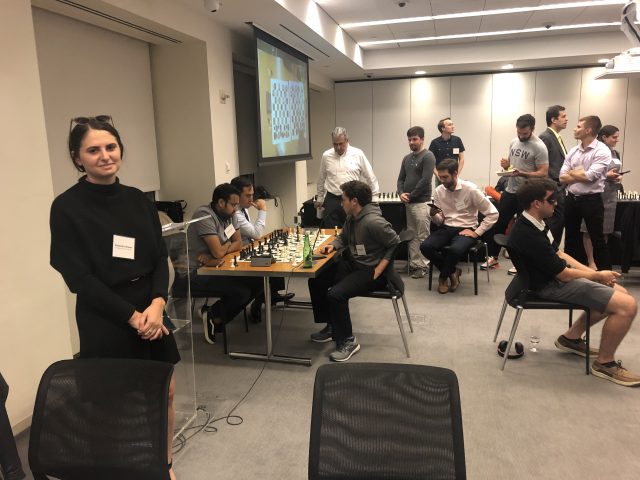 One of the simul challengers was Debevoise’s own P. Sebastian Ruiz, senior corporate Finance associate attorney. The other contender was Bhaumik Doshi, Process Improvement Strategist at JPMC. Foreground: Corporate Chess League co-founder Alex Wiener
One of the simul challengers was Debevoise’s own P. Sebastian Ruiz, senior corporate Finance associate attorney. The other contender was Bhaumik Doshi, Process Improvement Strategist at JPMC. Foreground: Corporate Chess League co-founder Alex Wiener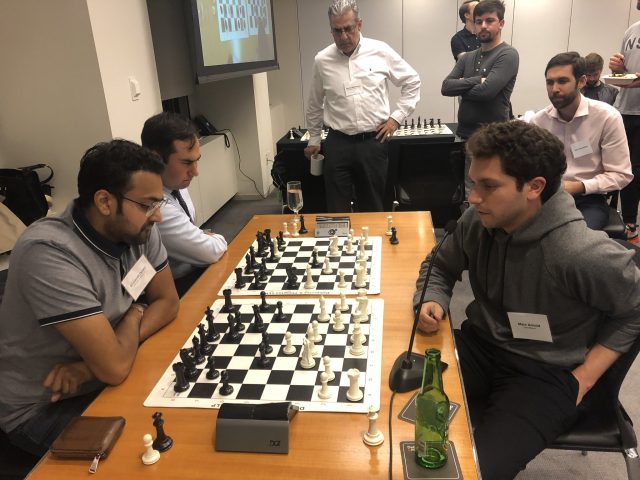 GM Marc Arnold moderated the simul and kindly resumed his duties this year as guest arbiter for a few matches.
GM Marc Arnold moderated the simul and kindly resumed his duties this year as guest arbiter for a few matches. The second match hosted an exclusive presentation from US Chess Woman’s Program Director WGM Jennifer Shahade on the emerging overlap between chess and poker.
Match 3 featured, by popular demand, a beginner workshop led by FM Alisa Melekhina who covered a classical game by Alekhine on the theme of “playing with purpose.”
The strong selection of titled players and solid masters and experts rounding off teams, makes this season especially competitive. After the halfway point, Goldman Sachs leads as the only team with 3/3 points. Three teams are tied for second place: Deutsche Bank, Google, and Debevoise. The matches will continue on a bi-weekly Thursday schedule, culminating with the closing ceremony and a tandem team exhibition match at the finale on Thursday, November 21. The NYCCL is made possible due to the top-notch work from Debevoise’s marketing, conference services, building security, and catering staffs. The Debevoise chess team line-up for the 2019 season includes: FM Alisa Melekhina, David Rock, Aleksei (“Alex”) Romanovski, P. Sebastian Ruiz, Ben Lee Friedman, and Saul Dingfelder. About the New York City Corporate Chess League The NYCCL brings together chess players employed at various firms and corporations with offices in New York City. The league is comprised of three-player teams; each player engages in a double match of G/10 + 3’ (once with white and black) during a single match. The season typically includes six total matches spanning two months. Games are not rated, although players’ reported USCF and/or FIDE ratings are used for pairing purposes. All players participate in their personal capacity, and must all be employed by the same private entity to form a team. Membership and attendance is free, but is currently by invitation only. Debevoise & Plimpton LLP is the host of the 2018 and 2019 seasons. For more information, contact [email protected] and [email protected]. *FM Alisa Melekhina is a long-time competitor in US open tournaments and women’s national and world team invitational events. She graduated from the University of Pennsylvania Law school in May 2014 and is currently practicing as a corporate litigation attorney in NYC. She previously wrote a popular CLO article on Balancing Law School and Chess.
Categories
Archives
- January 2026 (2)
- December 2025 (27)
- November 2025 (29)
- October 2025 (39)
- September 2025 (27)
- August 2025 (29)
- July 2025 (43)
- June 2025 (25)
- May 2025 (24)
- April 2025 (29)
- March 2025 (29)
- February 2025 (20)
- January 2025 (24)
- December 2024 (34)
- November 2024 (18)
- October 2024 (35)
- September 2024 (23)
- August 2024 (27)
- July 2024 (44)
- June 2024 (27)
- May 2024 (31)
- April 2024 (51)
- March 2024 (34)
- February 2024 (25)
- January 2024 (26)
- December 2023 (29)
- November 2023 (26)
- October 2023 (37)
- September 2023 (27)
- August 2023 (37)
- July 2023 (47)
- June 2023 (33)
- May 2023 (37)
- April 2023 (45)
- March 2023 (37)
- February 2023 (28)
- January 2023 (31)
- December 2022 (23)
- November 2022 (32)
- October 2022 (31)
- September 2022 (19)
- August 2022 (39)
- July 2022 (32)
- June 2022 (35)
- May 2022 (21)
- April 2022 (31)
- March 2022 (33)
- February 2022 (21)
- January 2022 (27)
- December 2021 (36)
- November 2021 (34)
- October 2021 (25)
- September 2021 (25)
- August 2021 (41)
- July 2021 (36)
- June 2021 (29)
- May 2021 (29)
- April 2021 (31)
- March 2021 (33)
- February 2021 (28)
- January 2021 (29)
- December 2020 (38)
- November 2020 (40)
- October 2020 (41)
- September 2020 (35)
- August 2020 (38)
- July 2020 (36)
- June 2020 (46)
- May 2020 (42)
- April 2020 (37)
- March 2020 (60)
- February 2020 (38)
- January 2020 (45)
- December 2019 (34)
- November 2019 (35)
- October 2019 (42)
- September 2019 (45)
- August 2019 (56)
- July 2019 (44)
- June 2019 (35)
- May 2019 (40)
- April 2019 (48)
- March 2019 (61)
- February 2019 (39)
- January 2019 (30)
- December 2018 (29)
- November 2018 (51)
- October 2018 (45)
- September 2018 (29)
- August 2018 (49)
- July 2018 (35)
- June 2018 (31)
- May 2018 (39)
- April 2018 (31)
- March 2018 (26)
- February 2018 (33)
- January 2018 (30)
- December 2017 (26)
- November 2017 (24)
- October 2017 (30)
- September 2017 (30)
- August 2017 (31)
- July 2017 (28)
- June 2017 (32)
- May 2017 (26)
- April 2017 (37)
- March 2017 (28)
- February 2017 (30)
- January 2017 (27)
- December 2016 (29)
- November 2016 (24)
- October 2016 (32)
- September 2016 (31)
- August 2016 (27)
- July 2016 (24)
- June 2016 (26)
- May 2016 (19)
- April 2016 (30)
- March 2016 (36)
- February 2016 (28)
- January 2016 (32)
- December 2015 (26)
- November 2015 (23)
- October 2015 (16)
- September 2015 (28)
- August 2015 (28)
- July 2015 (6)
- June 2015 (1)
- May 2015 (2)
- April 2015 (1)
- February 2015 (3)
- January 2015 (1)
- December 2014 (1)
- July 2010 (1)
- October 1991 (1)
- August 1989 (1)
- January 1988 (1)
- December 1983 (1)


